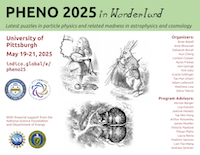Conveners
Machine Learning: Methods
- Jessie Micallef (Tufts University (and MIT))
Machine Learning: Data Applications
- Konstantin Matchev (University of Alabama (US))
We investigate the flavour sector of the supersymmetric SU(5) Grand Unified Theory (GUT) model using machine learning techniques. The minimal SU(5) model is known to predict fermion masses that disagree with observed values in nature. There are two well-known approaches to address this issue: one involves introducing a 45-representation Higgs field, while the other employs a higher-dimensional...
The bias-variance tradeoff is a well-recognized phenomenon in statistics and machine learning. In this talk, I will discuss an extension, dubbed the bias-variance-correlation tradeoff. Roughly speaking, as the flexibility of a model decreases, the correlations in the outputs of a trained model for different inputs increases. Such correlations have implications for several applications of...
Theoretical understanding of deep learning remains elusive despite its empirical success. In this study, we propose a novel "synaptic field theory" that describes the training dynamics of synaptic weights and biases in the continuum limit. Unlike previous approaches, our framework treats synaptic weights and biases as fields and interprets their indices as spatial coordinates, with the...
We propose $w_i f_i$ ensembles, a novel framework to obtain asymptotic frequentist uncertainties on density ratios in the context of neural ratio estimation. In the case where the density ratio of interest is a likelihood ratio conditioned on parameters, for example a likelihood ratio of collider events conditioned on parameters of nature, it can be used to perform simulation-based inference...
While the nature of fast radio bursts (FRBs) remains unknown, population-level analyses can elucidate underlying structure in these signals. In this study, we employ deep learning methods to both classify FRBs and analyze structural patterns in the latent space learned from the Blinkiverse FRB Survey dataset. We adopt a Supervised Variational Autoencoder (SVAE) architecture which combines the...
We present a method to suppress pileup and calibrate hadronic jet energy at L1 triggers using boosted decision trees for regression and classification. The fwX platform is used for implementation of BDTs on FPGA within the necessary timing and resource constraints. The in-situ pileup suppression can improve trigger performance in the high pileup environment of the HL-LHC.
We present NomAD (Nanosecond Anomaly Detection), an unsupervised machine learning algorithm developed for real-time anomaly detection in the ATLAS Level-1 Topological (L1Topo) trigger during Run 3. Combining a Variational Autoencoder with Decision Tree Regression, NomAD identifies rare and unconventional events in FPGA-based trigger hardware with low latency. Applied to dimuon events, the...
An excess of gamma rays from the Galactic center is observed by the Fermi Space Telescope. The two leading hypotheses for the cause of this excess are millisecond pulsars or dark matter. Generically, we expect the statistics of these two sources to differ. We train a graph convolutional neural network (NN) to accurately determine the relative flux contribution of point sources to the...
We present the first study of anti-isolated Upsilon decays to two muons (Υ→μ+μ−) in proton-proton collisions at the Large Hadron Collider. Using a machine learning (ML)-based anomaly detection strategy, we "rediscover" the Υ in 13 TeV CMS Open Data from 2016, despite overwhelming anti-isolated backgrounds. We elevate the signal significance to 6.4σ using these methods, starting from 1.6σ using...
The conservation of baryon number in the Standard Model originates from an empirical symmetry and does not derive from first principles. Any discovery of a phenomenon that indicates that this symmetry is broken would have far-reaching consequences for our understanding of the universe, in particular the origin of the matter-antimatter asymmetry. A proposed process that can violate baryon...
Score based and consistency diffusion models are presented for generating jet images, focusing on high-fidelity synthesis for high energy Physics applications. Using the JetNet dataset, the diffusion models are trained to learn the visual representation of jet kinematics. The results demonstrate that consistency models achieve significantly lower Fréchet inception distance measures compared...

